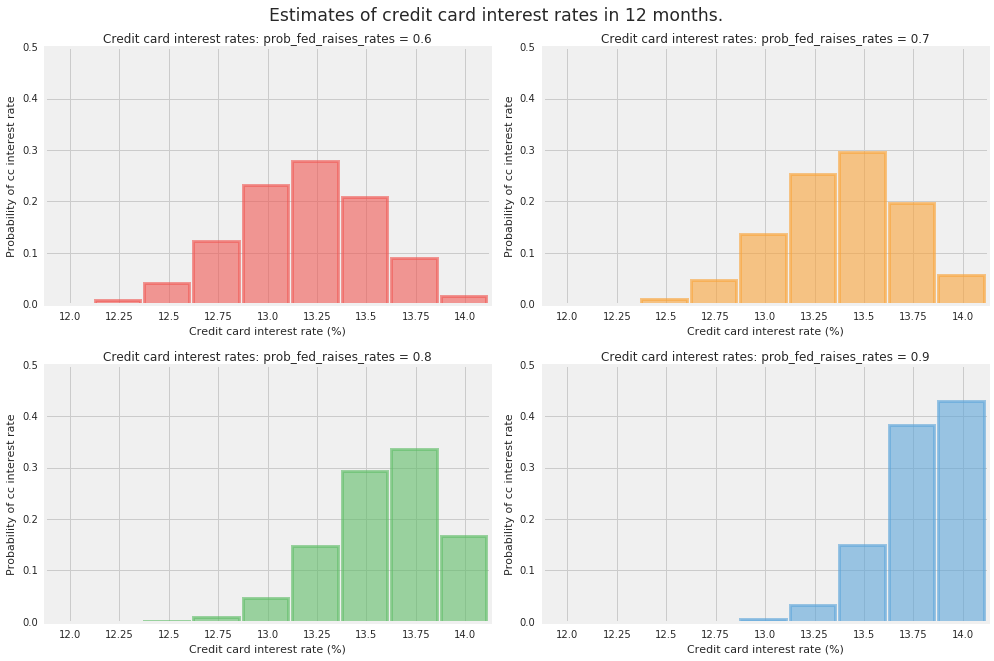בואו נדמיין שתרצו להעריך את הריבית על כרטיס האשראי שלכם בעוד שנה מהיום. נניח ששיעור הפריים הנוכחי הוא 2% וחברת כרטיסי האשראי שלך גובה ממך 10% פלוס פריים. בהתחשב בחוזקה של הכלכלה הנוכחית, אתה מאמין שהפדרל ריזרב צפוי להעלות את הריבית יותר מאשר לא. הפד ייפגש שמונה פעמים ב-12 החודשים הקרובים, או שיעלה את הריבית הפדרלית ב-0.25% או ישאיר אותו ברמה הקודמת.
אנו משתמשים בהתפלגות הבינומית כדי לדגמן את שיעור הריבית של כרטיס האשראי שלך בתום תקופה של שנים עשר החודשים. באופן ספציפי, נשתמש במחלקת ההתפלגות הבינומית של TensorFlow עם הפרמטרים הבאים: total_count = 8 (מספר ניסויים או פגישות), probs = {.6, .7, .8, .9}, עבור טווח ההערכות שלנו בערך ההסתברות שהפד יעלה את ריבית הקרנות הפדרליות ב-0.25% בכל פגישה.
תלות ותנאים מוקדמים
הגדרות התקנת TensorFlow Probability
TFP_Installation = "Stable TFP"
if TFP_Installation == "Most Recent TFP":
!pip install -q tfp-nightly
print("Most recent TFP version installed")
elif TFP_Installation == "Stable TFP":
!pip install -q --upgrade tensorflow-probability
print("Up-to-date, stable TFP version installed")
elif TFP_Installation == "Stable TFP-GPU":
!pip install -q --upgrade tensorflow-probability-gpu
print("Up-to-date, stable TFP-GPU version installed")
print("(make sure GPU is properly configured)")
elif TFP_Installation == "Most Recent TFP-GPU":
!pip install -q tfp-nightly-gpu
print("Most recent TFP-GPU version installed")
print("(make sure GPU is properly configured)")
elif TFP_Installation == "TFP Already Installed":
print("TFP already installed in this environment")
pass
else:
print("Installation Error: Please select a viable TFP installation option.")
יבוא ומשתנים גלובליים (הקפד להפעיל את התא הזה)
from __future__ import absolute_import, division, print_function
warning_status = "ignore"
import warnings
warnings.filterwarnings(warning_status)
with warnings.catch_warnings():
warnings.filterwarnings(warning_status, category=DeprecationWarning)
warnings.filterwarnings(warning_status, category=UserWarning)
import numpy as np
import os
matplotlib_style = 'fivethirtyeight'
import matplotlib.pyplot as plt; plt.style.use(matplotlib_style)
import matplotlib.axes as axes;
from matplotlib.patches import Ellipse
%matplotlib inline
import seaborn as sns; sns.set_context('notebook')
notebook_screen_res = 'png'
%config InlineBackend.figure_format = notebook_screen_res
import tensorflow as tf
# Eager Execution
use_tf_eager = True
# Use try/except so we can easily re-execute the whole notebook.
if use_tf_eager:
try:
tf.compat.v1.enable_eager_execution()
except:
reset_session()
import tensorflow_probability as tfp
tfd = tfp.distributions
tfb = tfp.bijectors
def default_session_options(enable_gpu_ram_resizing=True,
enable_xla=False):
"""Creates default options for Graph-mode session."""
config = tf.ConfigProto()
config.log_device_placement = True
if enable_gpu_ram_resizing:
# `allow_growth=True` makes it possible to connect multiple
# colabs to your GPU. Otherwise the colab malloc's all GPU ram.
config.gpu_options.allow_growth = True
if enable_xla:
# Enable on XLA. https://www.tensorflow.org/performance/xla/.
config.graph_options.optimizer_options.global_jit_level = (
tf.OptimizerOptions.ON_1)
return config
def reset_session(options=None):
"""Creates a new global, interactive session in Graph-mode."""
if tf.executing_eagerly():
return
global sess
try:
tf.reset_default_graph()
sess.close()
except:
pass
if options is None:
options = default_session_options()
sess = tf.InteractiveSession(config=options)
def evaluate(tensors):
"""Evaluates Tensor or EagerTensor to Numpy `ndarray`s.
Args:
tensors: Object of `Tensor` or EagerTensor`s; can be `list`, `tuple`,
`namedtuple` or combinations thereof.
Returns:
ndarrays: Object with same structure as `tensors` except with `Tensor` or
`EagerTensor`s replaced by Numpy `ndarray`s.
"""
if tf.executing_eagerly():
return tf.contrib.framework.nest.pack_sequence_as(
tensors,
[t.numpy() if tf.contrib.framework.is_tensor(t) else t
for t in tf.contrib.framework.nest.flatten(tensors)])
return sess.run(tensors)
class _TFColor(object):
"""Enum of colors used in TF docs."""
red = '#F15854'
blue = '#5DA5DA'
orange = '#FAA43A'
green = '#60BD68'
pink = '#F17CB0'
brown = '#B2912F'
purple = '#B276B2'
yellow = '#DECF3F'
gray = '#4D4D4D'
def __getitem__(self, i):
return [
self.red,
self.orange,
self.green,
self.blue,
self.pink,
self.brown,
self.purple,
self.yellow,
self.gray,
][i % 9]
TFColor = _TFColor()
חישוב הסתברויות
חשב את ההסתברויות לשיעורי ריבית אפשריים בכרטיס אשראי בעוד 12 חודשים.
# First we encode our assumptions.
num_times_fed_meets_per_year = 8.
possible_fed_increases = tf.range(
start=0.,
limit=num_times_fed_meets_per_year + 1)
possible_cc_interest_rates = 2. + 10. + 0.25 * possible_fed_increases
prob_fed_raises_rates = tf.constant([0.6, 0.7, 0.8, 0.9]) # Wild guesses.
# Now we use TFP to compute probabilities in a vectorized manner.
# Pad a dim so we broadcast fed probs against CC interest rates.
prob_fed_raises_rates = prob_fed_raises_rates[..., tf.newaxis]
prob_cc_interest_rate = tfd.Binomial(
total_count=num_times_fed_meets_per_year,
probs=prob_fed_raises_rates).prob(possible_fed_increases)
בצע קוד TF
# Convert from TF to numpy.
[
possible_cc_interest_rates_,
prob_cc_interest_rate_,
prob_fed_raises_rates_,
] = evaluate([
possible_cc_interest_rates,
prob_cc_interest_rate,
prob_fed_raises_rates,
])
דמיינו תוצאות
plt.figure(figsize=(14, 9))
for i, pf in enumerate(prob_fed_raises_rates_):
plt.subplot(2, 2, i+1)
plt.bar(possible_cc_interest_rates_,
prob_cc_interest_rate_[i],
color=TFColor[i],
width=0.23,
label="$p = {:.1f}$".format(pf[0]),
alpha=0.6,
edgecolor=TFColor[i],
lw="3")
plt.xticks(possible_cc_interest_rates_ + 0.125, possible_cc_interest_rates_)
plt.xlim(12, 14.25)
plt.ylim(0, 0.5)
plt.ylabel("Probability of cc interest rate")
plt.xlabel("Credit card interest rate (%)")
plt.title("Credit card interest rates: "
"prob_fed_raises_rates = {:.1f}".format(pf[0]));
plt.suptitle("Estimates of credit card interest rates in 12 months.",
fontsize="x-large",
y=1.02)
plt.tight_layout()



 הפעל ב-Google Colab
הפעל ב-Google Colab צפה במקור ב-GitHub
צפה במקור ב-GitHub